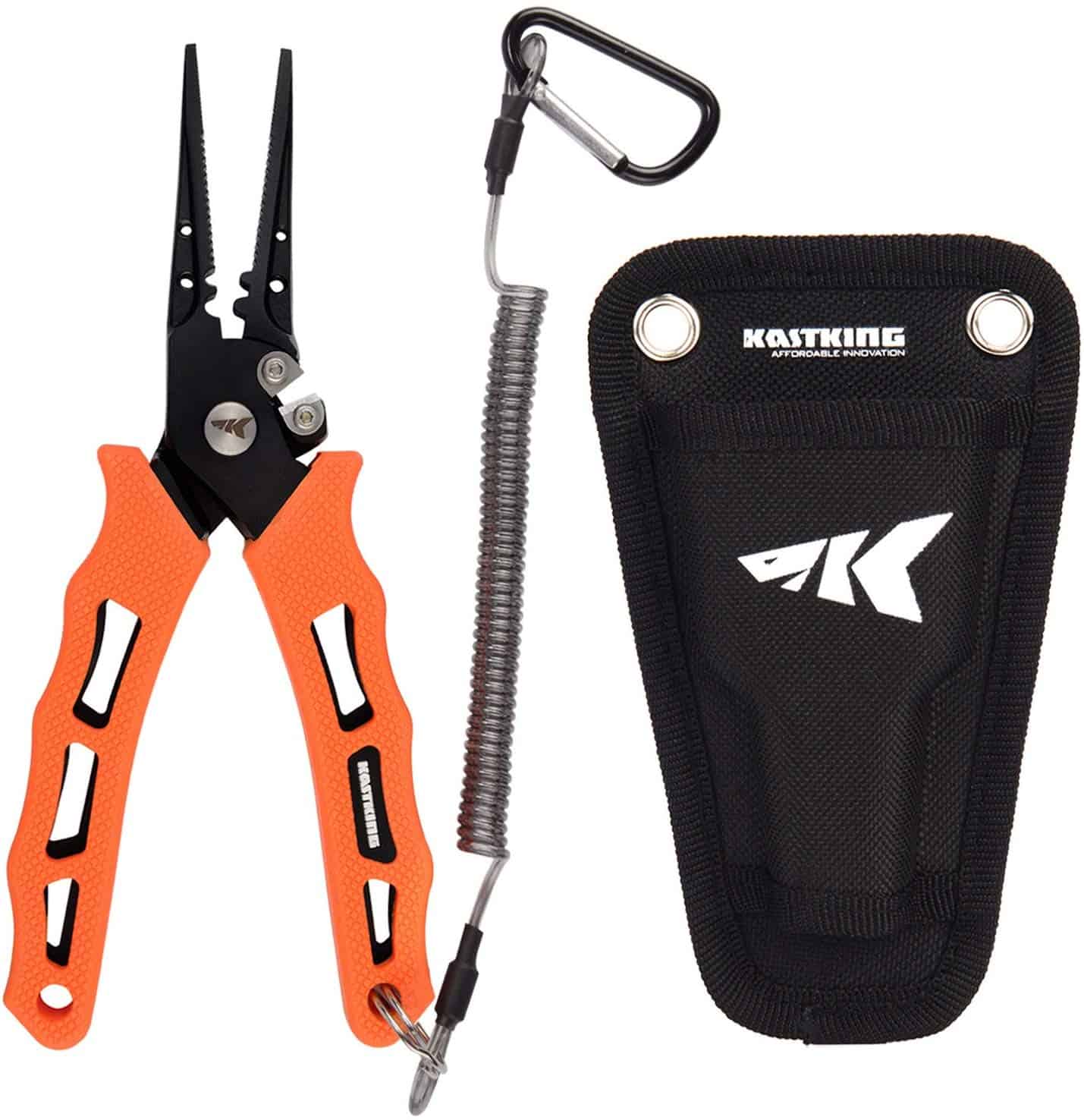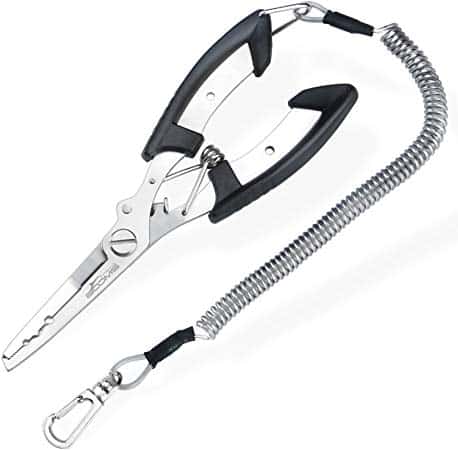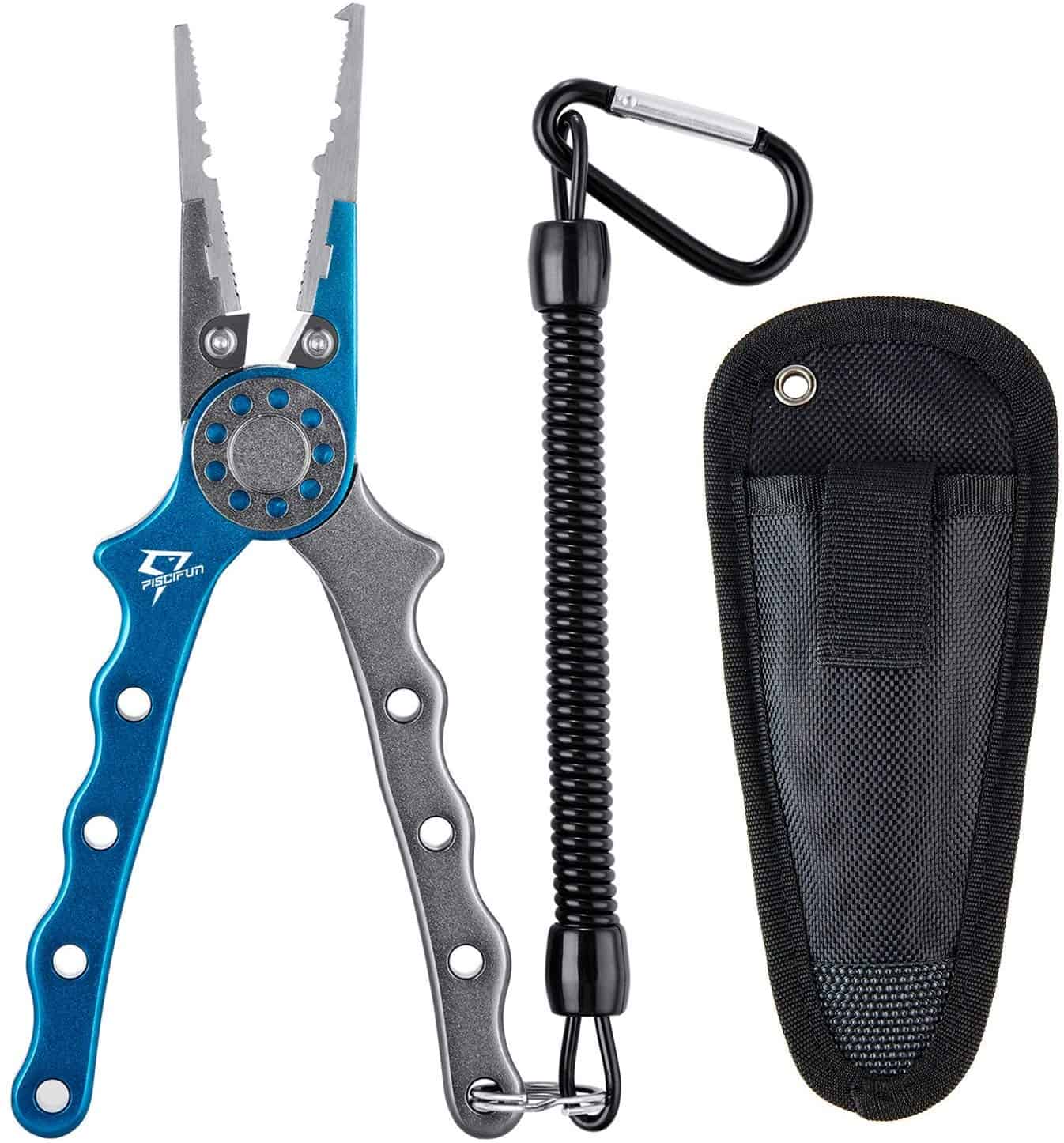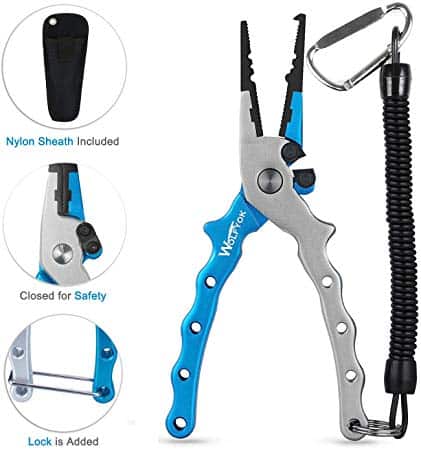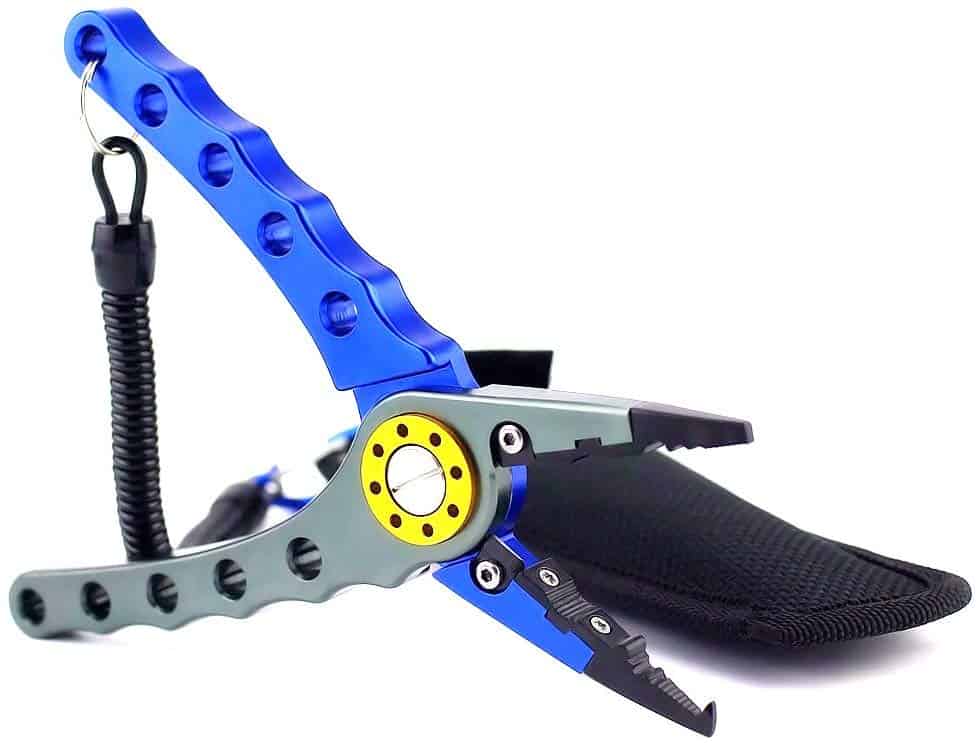Top 5 Best Fishing Pliers Reviewed for 2021
Our experts like to share product recommendations with you and hope you like them! Just to make you aware, CatchThemEasy may collect a small share of sales or other compensation from the links on this page.

A good pair of fishing pliers is an essential piece of equipment for all anglers. They can be used for a variety of different tasks such as removing hooks and cutting line – saving you both a great deal of time and effort.
As there are currently a vast number of pliers on the market, choosing the ones to suit you is no easy task.
Here I will be providing a quick overview of some of the very best fishing pliers currently available to help you in making your purchase.
Top 5 Rated Model Comparison Table
Image | Product | Price |
|---|---|---|
Best Fishing Pliers Review: Our Top 5 Picks
The Kastking Cutthroat stainless steel pliers are available in both a straight nose and a split ring nose design. They are well manufactured for long-term use in both fresh and saltwater environments.
Features
The Teflon coating on 420 stainless steel means that these pliers are both rust and corrosion-resistant. The tungsten carbide cutters can be used to slice through mono, fluorocarbon, or braid easily.
The handle is made from ergonomic textured rubber, making the pliers easier to grip and control. Additionally, the spring-loaded jaws allow for single-hand use.
The pliers can be used to grab and remove any hooks, secure a split shot weight, build a steel leader, and quickly cinch down a knot.
Pros
- Stronger and more robust than aluminum alternatives.
- Comfortable handle that allows for excellent control.
- Color makes them easy to see when dropped.
Cons
- Rusting could be an issue without proper storage and care.
- No locking function to keep the pliers closed when not in use.
- Lanyard carabiner a little flimsy.
Customer Sentiments
These pliers are thought to be well-constructed for constant and consistent use, even for people with larger hands. Users particularly like the easy-grip handles. Some users did mention issues with rust, so these pliers do need to be maintained a little more carefully.
These affordable 6.5-inch stainless steel fishing pliers have been specially designed for young anglers who enjoy fishing recreationally for small and medium-sized fish.
Features
The pliers are manufactured from 420 stainless steel with an ABS plastic handle for a comfortable and convenient grip.
The jaws are slim, making them ideal for removing hooks from freshwater fish such as bass and crappie.
They are also suitable for cutting braid and wire, and they feature a split ring tool which can be used for changing or replacing hooks.
Pros
- Spring-loaded handle for more effortless operation.
- Narrow serrated jaws for better reach and grip.
- Lock function to keep the pliers closed when not in use.
- Low price.
Cons
- Unsuitable for saltwater use.
- Harder to use for people with big hands.
- Not as sturdy as other options.
Customer Sentiments
Most users consider these pliers to be a useful piece of kit that is handy to have around and cheap to replace if lost or damaged.
The Piscifun multipurpose fishing pliers, constructed from aircraft-grade anodized aluminum, are durable and suitable for heavy and extended use.
Features
The aluminum body, combined with a stainless steel jaw and tungsten carbide Cutters means that these pliers are strong, sharp, and corrosion-resistant.
The spring-loading ensures that the jaws remain in the open position for ease of use and the machine cut handles are specifically designed to fit the contours of your hand.
With these pliers, you can cut braided fishing line, crimp sleeves and leads and remove hooks.
Pros
- Constructed from anti-corrosion aluminum for improved durability.
- Interchangeable blades.
- Titanium coated steel jaw for improved weather resistance.
- Lightweight and easy to maneuver
Cons
- Not as sturdy as stainless steel alternatives.
- Difficult to remove hooks from further down in the fish.
Customer Sentiments
Users were impressed with the high-quality feel of the product and considered these pliers to be excellent value for money as long as you keep in mind that they may bend if too much force is applied.
These lightweight pliers, made from aluminum alloy material, are a useful and versatile tool for all experienced anglers.
Features
Constructed from aluminum and with titanium - coated stainless steel jaws, these pliers can be used in both freshwater and saltwater environments. They also feature tungsten carbide Cutters for exceptional cutting power.
The spring-loaded handles have been specially shaped to allow for improved grip, and the bright color makes them easy to spot amongst your kit.
The pliers can be used to remove fish hooks, crimp and press leads, crimp sleeves and cut fishing lines.
Pros
- Aircraft-grade aluminum body for better saltwater resistance.
- Extremely lightweight at just 0.218 lbs.
- Lockable jaws for safe transportation.
Cons
- Handle can be difficult to grip when wet.
Customer Sentiments
Most users are happy with the lightness and feel of the pliers. They and consider them to be a valuable part of their fishing equipment. Although, they do mention that the split ring tool is more suited to light tackle.
Durable enough for regular use, these pliers have been specially designed with saltwater fishing in mind.
Features
The body is constructed from special deluxe aluminum and the jaws from stainless steel. An additional anodize coating provides extra protection from the elements.
The 7.1-inch pliers feature a high-density skid-proof handle making it easier to extract embedded hooks.
The pliers can be used for removing fish hooks and for cutting braided line and wire steel.
Pros
- Ultra-sharp line cutters.
- Slip-resistant jaws.
- Good spring mechanism
Cons
- Hard to grip when wet.
- Sheath isn’t very durable.
- Teeth don’t touch.
Customer Sentiments
These are thought to generally be good quality pliers. Some users have had rust issues if they didn’t rinse them directly after using them in saltwater environments.
What to Look For in Fishing Pliers
Functions
Many pliers these days have been designed to be multipurpose to save anglers space in their kit and time searching for the right tool. However, not all pliers have been designed equally. Some excel at one task over the others.
When making a purchase, take time to check through the reviews to gain an understanding of how suitable the design and functionality is for the primary purpose of your pliers.
You may want to look for different features depending on the species of fish you are aiming to catch. For example, some require long, thin jaws for ease of hook extraction without causing damage, whereas others may require greater strength in the body of the pliers.
Spring-loaded handles also can make pliers easier to use with just one hand. To avoid any accidents, make sure that these pliers also come equipped with a lock to keep the jaws together when they are not in use.
Lightweight construction makes them more portable and less of a burden for you to carry around when you are already loaded down with heavy fishing gear.
The split ring tool on many brands makes it quicker and easier for you to switch hooks and bait.
Materials
There are two types of materials generally used for fishing pliers – aluminum and stainless steel. Both of these products have advantages and disadvantages.
Aluminum is a lightweight metal that doesn’t rust, potentially making this a better option for saltwater fishing. However, it is not quite as sturdy as steel. Any force applied to the pliers could result in them bending or even breaking.
Stainless steel is more substantial but less weather-resistant than aluminum, so pliers made from this material may not always be suitable for use in saltwater. However, the metal’s strength means that they are less likely to be damaged even when extracting the hardest to remove hooks.
Whichever material you choose, you want to opt for the best quality available. Aircraft-grade aluminum is an increasingly popular option as it offers increased durability and better protection against corrosion.
Grade 420 stainless steel is the most robust type of steel around. Titanium or Teflon coatings are often used to increase its resistance to rust and corrosion.
Many brands pair aluminum bodies with stainless steel jaws for the best of both worlds. This offers improved strength but just keep in mind that you will need to take care of the steel elements when using the pliers in saltwater.
Comfort
As you’re likely to be using your pliers often and for some tricky tasks, it’s vital to ensure that the design allows for both better comfort and ease of use.
The first thing to consider is the size of the pliers. Smaller pliers may be difficult for a person with large hands to hold and operate. 7 inches is the standard size of pliers, and this should be suitable for a person of average hand size.
If your hands are on the larger size, you may want to opt for bigger pliers are smaller ones may be more difficult for you to operate.
Additionally, an ergonomically designed silicone or rubber handle is likely to make pliers easier to grip, especially when they are wet. It’s also better for your hands when using the tool frequently or with effort.
Storage
As with all products, proper care and storage of your pliers will maintain their performance and significantly increase the time you can keep them before they need to be replaced.
It is essential that you rinse your pliers with fresh water after every use – particularly if you have been using them for saltwater fishing. Any neglect in this area could result in rust and/or corrosion of the steel elements of the product.
Treating your pliers occasionally with anti-rust spray is beneficial for preventing spotting on stainless steel models and on the screws, bearings, springs, and cutters.
Take care that they are dry before you pack them away. Store them in a cool, dry and secure place ready for your next fishing trip.
FAQs about Fishing Pliers
Why Do I Need Fishing Pliers?
Pliers are vital tools that often get overlooked – until you need them. Having a sturdy and well-designed pair of pliers can make all the difference on your fishing trip.
Pliers can be used to remove hooks from fish, to cut line, for crimping and to split rings when changing hooks.
Although other tools can be used for each of these jobs, having an all-in-one item saves you space in your kit and time searching around for other tools.
Are Particular Pliers Better for Different Types of Fishing?
The type of pliers needed depend on the environment you are fishing in – saltwater or freshwater, as well as the types of fish you are aiming to catch.
As a general rule, anglers who prefer saltwater should have pliers that are protected from rust and corrosion.
Saltwater fish also tend to be bigger and so pliers should have longer jaw sections to ensure that the hook can be extracted efficiently and safely.
What Kind of Accessories Are Usually Included With Fishing Pliers?
Most pliers these days come equipped with a sheath that can be attached to a belt. They also tend to have a lanyard with a carabiner so they can be securely attached to the sheath while in use. This means that your pliers are more likely to remain in your hand and not end up at the bottom of a river or ocean somewhere.
Just take care that these accessories are as well constructed as the pliers they are holding and not likely to fall apart when being used.
Verdict
Although the pliers reviewed above all offer similar styles and functions, for me, the best of these has to be the Wolfyok Aluminum Fishing Pliers.
These brightly colored, and excellently designed pliers have a significant number of features for the price including the aircraft-grade aluminum body and tungsten carbide Cutters.
Users raved about their lightweight yet robust construction and excellent functionality. They were also impressed with the accompanying sheath and lanyard.
Overall, these pliers are suitable for use in all types of water and, with due care, are incredibly durable. They would make a useful addition to any angler’s kit.
For further details, make sure to check out detailed Fishing Guide.

